Diagnosis with a tomograph allows you to get a high quality image of many organs of the human body.
MRI is recognized as one of the best methods for examining soft tissues, which is considered harmless to health.
Record content:
- 1 What is a tomograph?
- 2 How the device works
- 3 What kind of radiation does a person receive?
- 4 How long does an MRI take?
- 5 Feelings of the patient during the procedure
- 6 Health benefits and harms - which is more?
-
7 Why is MRI harmful to the body?
- 7.1 Adults
- 7.2 Pregnant
- 7.3 Children
- 8 How safe is contrast tomography? Will there be any consequences after its introduction?
- 9 Is a tomography of the brain harmful?
- 10 How often can an MRI be done?
- 11 When is it contraindicated to carry out diagnostics?
- 12 Is it dangerous to do an MRI for mentally unstable people?
- 13 What can replace magnetic resonance imaging?
- 14 MRI video
What is a tomograph?
Anatomical tomography is based on the physical analysis of the internal sections of the object. During the examination, organs and tissues are repeatedly translucent and examined in various directions.
Magnetic resonance imaging - one of the ways to visualize an organ using nuclear magnetic resonance. Examination using MRI allows you to obtain a mapping of all areas of the cerebral cortex, to study space inside blood vessels, biochemical shifts in connective tissues, blood movement along the body.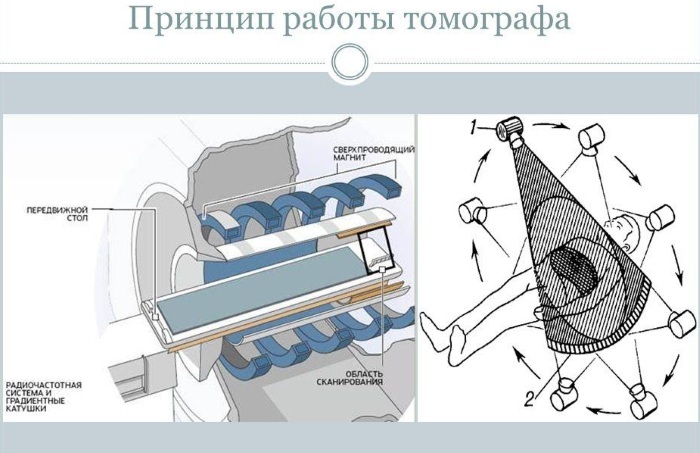
The tomograph gives an image of each layer of tissue, organ, and data processing takes place on a computer.
How the device works
MRI (is it harmful to health - doctors answer this question that it is not only safe, but also very informative) creates images using resonant radiation of electromagnetic energy.
A powerful magnet contained in the device generates radio waves. Under the influence of these waves, hydrogen ions vibrate in one direction. The frequency of vibrations is captured by the apparatus and converts them into an image that can be captured in any plane of the body.
Since the soft tissues of the human body contain a lot of water, and hydrogen is part of it, it is preferable to carry out studies using MRI in the area of soft tissues. Bone formations in the pictures that the MRI machine sends to the computer look like dark spots, so it is better to diagnose them with the help of CT.
The MRI method is used when it is necessary to assess;
- intracranial abnormalities;
- suspected tumors in the musculoskeletal system;
- abnormalities in the spine;
- spinal cord abnormalities;
- injuries and disorders in the internal joints;
- hepatic pathologies;
- changes in the female, male genitals;
- pathology of the nerve roots;
- the condition of the intervertebral discs.
MRI has several advantages:
- a magnetic field is used in the study, not X-rays;
- using the device, you can change the contrast of the image, highlight different areas and types of tissues;
- effective in detecting spinal cord tumors;
- gives a clear idea of the condition of the ligaments, muscles, nerves.

During the examination, the patient's body receives radio waves, which simultaneously affect the magnetic field. The device studies the reflected waves, analyzes them and makes a complete picture of the internal structures.
What kind of radiation does a person receive?
Unlike CT and X-rays, during MRI sessions, patients receive a zero dose of radiation, since the study is based on electromagnetic radiation.
How long does an MRI take?
Image processing can take from half an hour to 2 hours, it all depends on the complexity of the diagnosis. Procedures using a contrast agent increase the duration by 20-30 minutes.
| Organs under investigation | Time spent on research |
| Adrenal glands | 30 to 45 min. |
| Pituitary | 30 to 60 min. |
| Stomach | 20 to 40 min. |
| Hip joint | About 20 min. |
| Brain | About 1 hour |
| Kidney | 30 to 40 min. |
| A heart | 40 to 60 minutes |
| Abdominal cavity | 30 to 60 min. |
| Pelvic organs | From 30 min. up to 1 hour |
| Rib cage | Up to 90 min. |
| Knee-joint | From 30 min. Up to 1 hour |
| Liver | From 30 min. Up to 1.5 hours. |
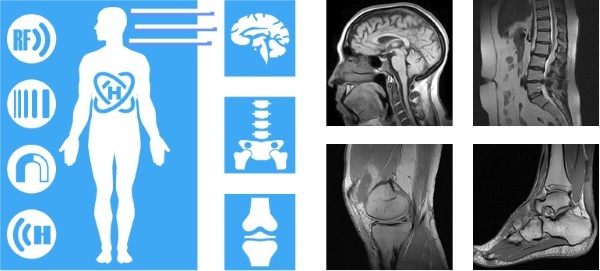
In some cases, diagnosing certain organs involves performing procedures not once, but twice.
Feelings of the patient during the procedure
Some patients experience a sense of dread during MRI sessions. This comes from placing them in an enclosed space. Sometimes there is a feeling of warmth in the body. The device makes a rather loud sound during the session and this disturbs the patients. You can get rid of it by using earplugs.
In the process of introducing a contrast agent, a person may experience a feeling of coolness, a rush of blood, but they persist for no more than 2 minutes, and then everything is normalized. Many people have a metallic taste in their mouths after the contrast.
If anesthesia was not applied before the session, then after the procedure, the rehabilitation moment is not provided.
Health benefits and harms - which is more?
The MRI technique includes many positive aspects in the absence of negative ones:
- Diagnosis is highly accurate.
- There are no painful sensations during the session.
- The procedure makes it possible to diagnose with a high degree of probability a brain disease, vascular pathology, and determines the presence of a hernial protrusion.
- Does not pose a health hazard to pregnant women after 1 trimester and babies.
- Images can be attached to any electronic medium.
- The permissible error percentage is less than 5%. (Erroneous primary diagnosis often depends on the incompetence of the doctor).
- There is no limit to the number of studies.
Risks that exist during the session:
- an allergy attack after the administration of a contrast agent, but most of the reactions stop immediately;
- energy of different frequencies used during scanning can lead to overheating of the body, this happens during long examinations.
Why is MRI harmful to the body?
According to Rospotrebnadzor statistics, during medical sessions using CT, X-rays and others, residents receive an annual radiation dose at the level of 0.47-0.51 with a certain limit of 1 millisievert. This is the established level for healthy people. For patients undergoing medical examinations, the level is set higher.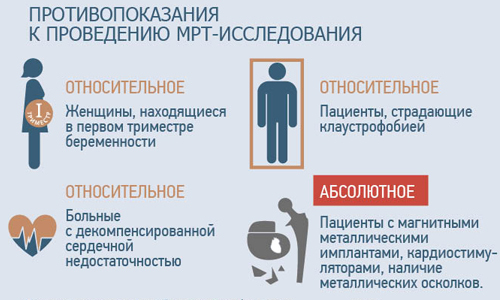
According to the WHO, the use of a magnetic field of no more than 1.5 T is considered safe for humans. Patients do not receive radiation exposure during MRI sessions.
The unfavorable moments of the sessions include burns that occur due to improper operation of scanners and MRI coils. This happens if the device was received from an unknown manufacturer or the inexperience of the doctor conducting the session. The percentage of burns is very small, 250 cases in the entire world practice.
Adults
Whether the MRI session will harm the patient, the doctor must decide. If the potential risk does not exceed the informative benefit of the session, then the decision should be in favor of the MRI procedure. For biased reasons, it is not worth giving up the study, because there are no alternative methods with such high information content.
A healthy person under 40 does not need to have a CT scan for no reason.
Pregnant
MRI (is it harmful to the health of a pregnant woman and her child - this question worries many women) is the safest type of examination after an ultrasound scan. But only the attending physician can recommend an MRI scan. As a rule, a procedure is prescribed in the absence of an alternative method of examining any organ. These may be suspicions of a developing tumor, trauma, stroke.
In some cases, permission is given to undergo a procedure to examine the fetus:
- when there are suspicions of the development of gross defects in the fetus, and ultrasound does not give a complete picture;
- poor location of the child, which makes it difficult to view him with an ultrasound scan;
- overweight pregnant woman, obstructing the view of the fetus during ultrasound examination.
Many specialists hesitate to refer pregnant women for an MRI scan in the first trimester. There is no objective data on the effect of magnetic fields on the fetus in this period, therefore, many gynecologists before 12-18 weeks of pregnancy do not send women to procedures using MRI.
As a contrast agent, pregnant women are offered the least toxic agents:
- Endoderm.
- Gastromak.
- Lumirem.
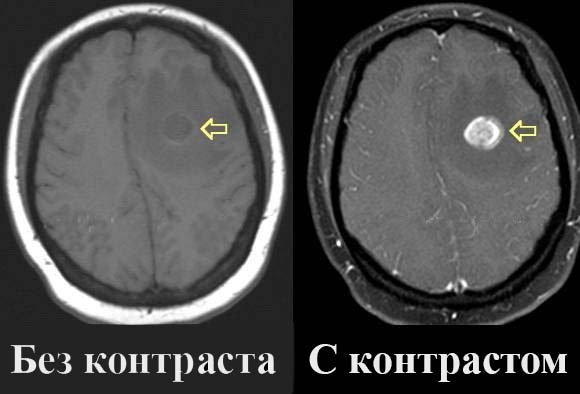
Contrasts are used in case of urgent need, for example, to identify metastases and tumors.
Children
All medical experts say that the MRI technique does not pose a danger to the health of children. The main problem that parents face during the session is the inability of some children to lie motionless for a certain time. For such fidgets, mild anesthesia is often used.
How safe is contrast tomography? Will there be any consequences after its introduction?
For a better study of vascular structures, inflammation and tumors, contrast is used in tomography. The contrast agent enhances the difference in signals between different tissues, which significantly improves the image, and therefore increases the diagnostic information.
The most commonly used substances are those containing paramagnetic gadolinium ions, which have magnetic properties. The essence of the use of contrast is that it changes the magnetic parameters of the protons of tissues and organs.
Side effects of gadolinium-based contrast agents:
- nausea;
- headache;
- cold reaction in the area of injection;
- distortion of taste sensations;
- relaxation of smooth muscles in the walls of blood vessels;
Is a tomography of the brain harmful?
The MRI procedure of the brain is completely safe for the patient in the absence of contraindications. Magnetic fields do not provoke tissue damage, do not cause discomfort, painful sensations. A magnetic field of up to 1.5 T is completely safe for the body.
The study of the cerebral cortex using tomography is a highly informative method in which the slightest changes in the arteries and veins that feed the brain are found out. During the MRI sessions, tumors and metastases are detected in the early stages.
When diagnosing areas of the brain, functional MRI is performed. This is a method of multiple images of the brain structure, ultra-fast flat mapping, which allows to determine the location of various brain structures responsible for movement, speech, memory, vision. The essence of the technique is that when a separate part of the brain is working, blood flow in it increases.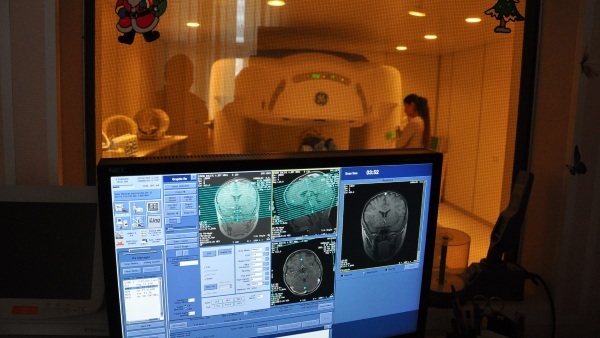
At the time of diagnosis, the patient is asked to perform certain tasks, while registering the areas of the brain in which an increase in blood flow has occurred. At this point, all images are superimposed on a standard MRI of the brain. This technique is called neuroimaging.
With its help, the normal functioning of the brain and its work under various pathological conditions are determined. MRI does not harm the brain. Health complications after sessions are not described in medical practice. Improvement in cerebral blood flow is sometimes seen as side effects.
How often can an MRI be done?
Magnetic resonance imaging can be done frequently, but it is best done when needed.
Doctors have developed general medical recommendations:
- MRI of the brain is recommended to be performed no more than once a year.
- Stroke patients should have a session 1-3 times a year.
- In case of suspicion of lesions that have appeared, characteristic of multiple sclerosis, you can be examined once every six months.
- In the presence of a herniated disc, the examination is carried out once every 2 years.
- During the postoperative recovery period, MRI sessions are performed several times a month.
If the patient is in the hospital, then the sessions are possible more often.
When is it contraindicated to carry out diagnostics?
MRI (whether the doctor will tell the health of certain groups of people) has relative and absolute contraindications.
| MRI procedures are absolutely contraindicated | MRI procedures are relatively contraindicated (under certain conditions) |
| Patients with pacemakers | Hemostatic clips for cerebral vessels |
| Electronic implants for the inner ear or made of ferromagnetic | Non ferromagnetic ear implants |
| Large metal implants contained in the body | Nerve stimulants |
| Ferromagnet shards | |
| Ilizarov apparatus made of ferromagnet | Heart valve prostheses |
| In the first trimester of pregnancy | |
| Decompensated myocardial dysfunction | |
| Permanent make-up with dyes containing metal | |
| Braces, dentures | |
| Claustrophobic | |
| Heavy weight patients |
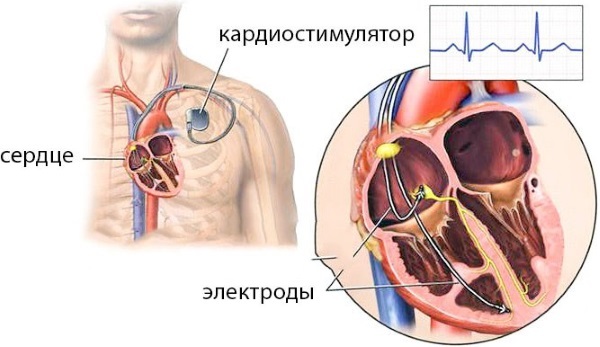
Under the influence of the magnetic field in the MRI machine, ferromagnets can be displaced because they contain iron. When displaced, the adjacent organ is sometimes damaged.
A ferromagnetic object is drawn into the magnetic channel of the apparatus at high speed, and the patient can get injured, incompatible with life. Patient's magnetically activated medical devices may intermittently, so testing should be done prior to examination.
Patients suffering from a fear of a confined space are offered a sedative before the session: alprazolam or prazepam.
Is it dangerous to do an MRI for mentally unstable people?
People with mental disorders, emotionally excitable, there are no restrictions in the passage of diagnostics with an MRI machine. The sessions do not affect the change in the human psyche.
MRI sessions are done for people with epilepsy to look for damaged cells.
What can replace magnetic resonance imaging?
The sensitivity of CT and MRI techniques consists of the physical properties of various tissues of the human body. In one case, it is useful for diagnosis to undergo an MRI session if the organs being examined contain a high amount of fluid, but are strongly protected by the bone skeleton. In other cases, when it is necessary to examine the bone structures, CT sessions are performed.
When diagnosing the digestive tract, glands, neck, kidneys, CT and MRI techniques become equivalent. However, CT examination is the fastest method, when the doctor must make the right decision instantly.
But it is possible to detail non-invasively and painlessly many internal parts of the human body with high accuracy only with the help of MRI. Standard MRI scans check how tissues in the human body behave and detect abnormalities in them.
MRI is not harmful to health, on the contrary, in 97% its effectiveness was noted for the accurate diagnosis of pathologies occurring in the body and their timely detection.
Author: Belyaeva Anna
Article design: Vladimir the Great
MRI video
About MRI and how it works:

